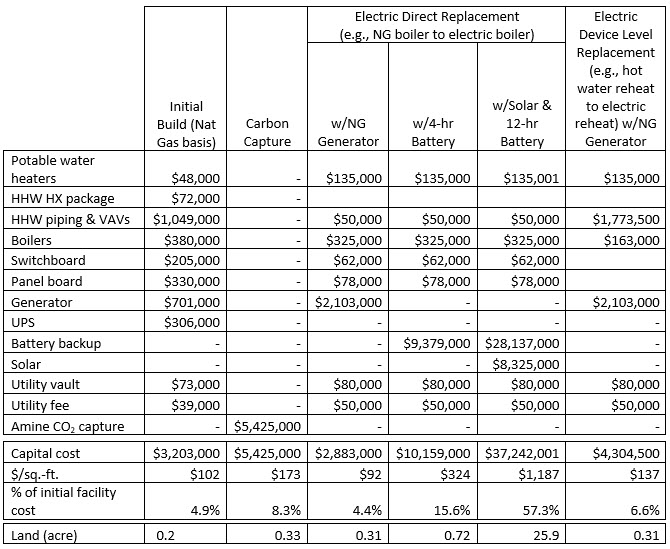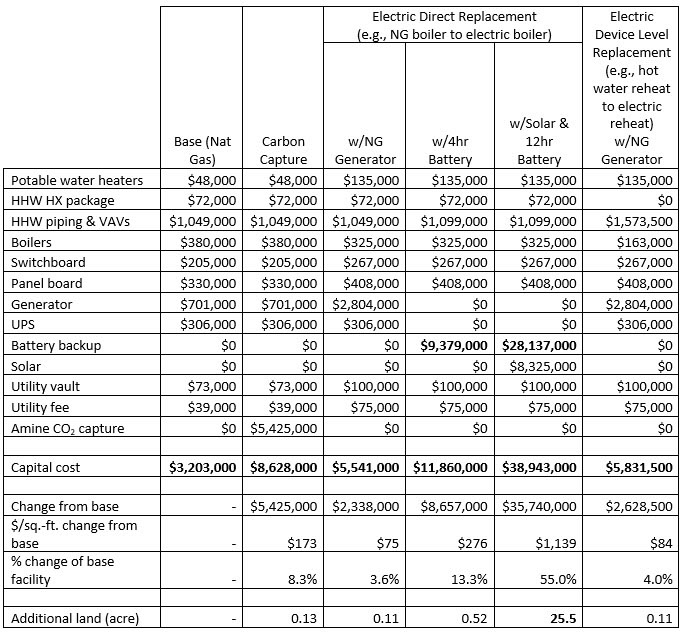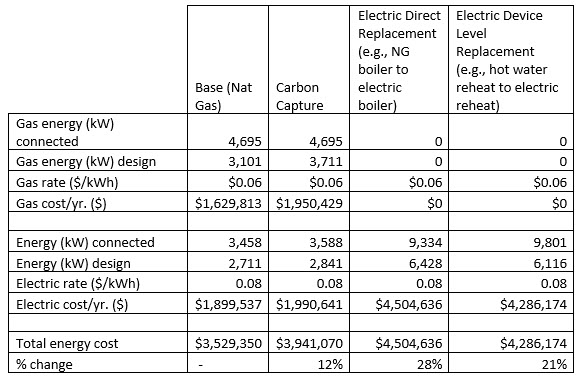Key Considerations For Decarbonizing Your Biotech Facility
 The biotechnology industry is in the business of improving human health and is actively working on reducing our carbon footprint while serving patients. The manufacturing processes for biopharmaceuticals do not directly utilize fossil fuels. However, fossil fuels are used in the generation of raw materials, consumables, and packaging and in supplying energy to building systems and indirectly to manufacturing equipment.
The biotechnology industry is in the business of improving human health and is actively working on reducing our carbon footprint while serving patients. The manufacturing processes for biopharmaceuticals do not directly utilize fossil fuels. However, fossil fuels are used in the generation of raw materials, consumables, and packaging and in supplying energy to building systems and indirectly to manufacturing equipment.
Other studies have looked at the impact of single-use systems and consumables on the environment.1 Various groups are working on reducing embedded carbon in raw materials.2 Over the years, the biotechnology industry has viewed sustainability through the lens of reducing energy usage, particularly regarding building systems and water treatment.3 Considering whether to decarbonize manufacturing has mostly been done internally within companies as part of capital project planning. This paper will provide a case study of an antibody drug substance production facility for retrofit and envisioned as new construction. The quantification of estimated costs, land use, and production scale limits can help in the capital planning process.
This quantification looks at a monoclonal antibody drug substance facility built in 2018/2019 with two stainless-steel upstream trains (2,300-L production bioreactors) feeding one single-use purification train.
Electrifying! The End Of Fired Equipment?
For the majority of facilities, building systems and process utilities rely on steam and hot water for major heating loads. The technology to replace fired steam boilers and hot water heaters with electrically heated units exists, but from a limited set of vendors. The cost analysis looked at two methods: direct replacement of fired equipment (e.g., steam boilers, hot water heaters) and distributed systems (e.g., point of use steam generation, electric re-heat coils). Electrification of these systems requires new electrical service and more backup generation capacity. While a particular facility might be in a location where the electrical infrastructure for this increase in demand is supported, the majority of facilities need upgraded grid connections and upgrades to the grid itself. The electrical infrastructure to transition the whole industry off natural gas and other fuel fossils doesn’t exist yet. Biogas has the potential to reduce global warming by converting escaping methane to CO2, which is 34 times less impactful to global warming.4 Although not a true decarbonization solution, biogas could be a bridging solution with the development of the infrastructure to mix/replace natural gas with biogas. The studied facility has a 2,500-KVA switchboard; electric boilers and hot water heaters would need a dedicated 6,000-KVA switchboard. Upon examination, there isn’t room for the additional gear within the facility and the utility company will need to provide a new larger feeder and transformer. In this case, those space constraints require a campus-wide approach with a new building for the gear and transformer pad. Only the cost of the gear is included in the cost analysis.
Manufacturing requires continuous power to minimize the risk of product loss. Replacing fired equipment with electrically heated equipment significantly increases the backup power demand. Today, that demand is met with diesel or natural gas engine generators. These demands are a large portion of the power going to the facility, and commercially available non-fossil fuel backup power solutions to meet that need are not viable. For example, the studied facility would need an additional plot of land larger than the building for batteries that provide only 4 hours of backup. Site layouts need to consider more than just the batteries and inverters. Large installations of batteries have building code-prescribed offsets from buildings, property lines, and other exposures. For example, NFPA 855 requires a remote installation (>100 feet from buildings, property lines, and public ways) for lithium-ion battery systems that exceed 600 kWh. Four hours of battery backup would add a cost premium of 14% to a new facility before land costs. Typically, facilities are looking for days of backup power, particularly in coastal areas affected by the increasing level of severe storms. Increasing the battery storage to a mere 12 hours and adding solar panels to provide sufficient power is a solution that is intensive in capital (over 50% increase in facility cost) and land use (~10 acres per MW required). Current battery technologies also introduce a new hazard to the community that could require new training and equipment for emergency response personnel. Hydrogen fuel cells or dual fuel engines are novel electrical generation systems that could become attractive for certain sites with the development of hydrogen infrastructure. To meet the backup power needs of the studied facility for 24 hours, ~52,000 L of liquid H2, or 3,600 kg, would be required. Due to the safety concerns associated with liquid hydrogen storage and the necessary handling technologies, this type of H2 storage is reserved for special applications.5 With the high expense of increased on-site generation equipment (combustion or renewable) high-reliability power transmission systems (mulitple sourced ring, mesh networks) could be more cost effective if available at the location.
Decarbonization of the biotech facility by using electricity doesn’t address carbon dioxide generation itself. The electric grid itself would need to undergo decarbonization. Consider that the generation of electric power in the U.S. (EIA 2021 source) consists of 38.3% by natural gas, 21.8% by coal burning, 18.9% by nuclear, and only 20.1% by “renewable” sources. Therefore, by ramping up biotech facilities’ use of electric power we are only shifting the carbon release from our plants’ properties to the local power generation facility, which uses, on average, 60% fossil fuel, and if we are in the Midwest U.S. or mid-Atlantic, we are shifting our “decarbonization” to one of the 241 coal burning plants. It should be noted the largest burning coal plants in the U.S. are in Illinois, North Carolina, and Michigan. These plants may be replaced with renewable energy sources or retrofitted with carbon capture technology as part of the grid decarbonization.
What About Carbon Capture?
Capturing carbon has been proposed as a way to retrofit existing systems in a “bolt-on” fashion. Commercially available carbon capture technology exists from limited vendors but results in significantly more fossil fuel burned. A carbon capture unit for the studied facility’s steam boilers would double the natural gas consumption of the facility and require doubling the facility’s plot size. Today’s commercial technology also introduces monoethanolamide (MEA), which presents health risks to the community if released. The addition of this chemical could require new training and equipment for emergency response personnel. The carbon capture unit would add a cost premium of 8% to the facility before land costs and adds 12% to the operating cost of the facility. This value is for modern low NOx boilers using an ultralow sulfur fuel (<15 ppm); boilers using fuel oil with higher sulfur content could need additional treatment equipment. The CO2 produced by this type of carbon capture system is of a quality that could be used for cell culture with compendial testing or resold to beverage manufacturers. At this time, resale solutions for the CO2 captured are highly variable by region globally, with many regions not having an existing solution for resale or disposal. From a practical perspective, the concept of carbon capture does not make sense with existing technology due to the health and safety mitigations required and the disposal difficulties. We as an industry cannot improve wellness in the world while we endanger our employees and the community.
Practical Considerations And Cost Comparisons
For existing facilities, uptime is paramount, so retrofits require careful consideration and planning. Boilers and heaters nearing their end of life could provide the best opportunity for retrofit as an outage will be needed for replacement regardless and the equipment will be fully depreciated. The complexity and cost of the demolition/repair portion of the work is going to vary significantly. One point is access; some facilities have rollup doors that can allow replacement of boilers. Most legacy facilities have boilers in more built-in locations, such as the lower floor of a multi-story utility complex, which will require significant ancillary demolition/repair. Table 1 compares the retrofit capital costs of the different options discussed, excluding demolition or write-off costs.
Table 1. Estimated retrofit capital costs in USD for ~32,000-sq.-ft. facility.

New builds present an opportunity to find economies in planning facility systems. If battery systems are going to be used for backup power, a UPS might not be required. The expense of piping can be reduced, particularly in the case of device-level replacement where heating hot water is completely removed. Utility connections and power distribution systems can be designed to the higher demand rather than adding in separate systems. The estimated cost impact to a new facility is shown in Table 2.
Table 2. Estimated new facility capital costs in USD for ~32,000-sq.-ft. facility.
You’ll see particularly high costs in bold.

With the change in how systems are heated, the operating cost changes. Table 3 shows a high-level impact on the cost to operate the building systems of the studied facility. With limited data on performance of electrical systems of this scale, maintenance, staffing, and differences in life expectancy are not included.
Table 3. Estimated operation costs in USD.

This quantification of estimated costs, land use, and production scale limits can help in the capital planning process. Decarbonized facilities will cost more to build, cost more to operate, use significantly more land, require upgrades to utility infrastructure (electrical and biogas), and require novel approaches for backup power. These factors require the industry to continue to focus short-term efforts on reduction of energy used and prepare for the future by engaging with utility providers.
References
- Kristi Budzinski, David Constable, Daniel D’Aquila, Phillip Smith, Sri R. Madabhushi, Andy Whiting, Tom Costelloe, Michael Collins, Streamlined life cycle assessment of single use technologies in biopharmaceutical manufacture, New Biotechnology, Volume 68, 2022, Pages 28-36, ISSN 1871-6784, https://doi.org/10.1016/j.nbt.2022.01.002.
- MilliporeSigma’s DOZN™ Green Chemistry Tool Named Top Project of the Year by Environment + Energy Leader, Merck KGaA, 30 JUL 2020, https://www.emdgroup.com/en/news/dozn-wins-top-project-award-30-07-2020.html
- Allan Hart, Airflow Reduction in Cleanrooms after Closing Hours, Pharmaceutical Engineering, November/December 2019
- Tim Juliani, Pete Pearson, Is Biogas a “Green” Energy Source?, World Wildlife Fund, 24 Sept 2020, https://www.worldwildlife.org/blogs/sustainability-works/posts/is-biogas-a-green-energy-source accessed 16 MAR 2022
- Storing Hydrogen, Air Liquide, https://energies.airliquide.com/resources-planet-hydrogen/how-hydrogen-stored, accessed 16 MAR 2022
About The Authors:
 Herman Bozenhardt has 45 years of experience in pharmaceutical, biotechnology, and medical device manufacturing, engineering, and compliance. He is a recognized expert in the area of aseptic filling facilities and systems and has extensive experience in the manufacture of therapeutic biologicals and vaccines. He has a B.S. in chemical engineering and an M.S. in system engineering, both from the Polytechnic Institute of Brooklyn. He can be reached via email at hermanbozenhardt@gmail.com and on LinkedIn.
Herman Bozenhardt has 45 years of experience in pharmaceutical, biotechnology, and medical device manufacturing, engineering, and compliance. He is a recognized expert in the area of aseptic filling facilities and systems and has extensive experience in the manufacture of therapeutic biologicals and vaccines. He has a B.S. in chemical engineering and an M.S. in system engineering, both from the Polytechnic Institute of Brooklyn. He can be reached via email at hermanbozenhardt@gmail.com and on LinkedIn.
 Erich Bozenhardt, PE, is the lead process engineer for regenerative medicine operations at United Therapeutics. He has 16 years of experience in the biotechnology and aseptic processing business and has led several biological manufacturing projects, including cell therapies, mammalian cell culture, and novel delivery systems. He has a B.S. in chemical engineering and an MBA, both from the University of Delaware.
Erich Bozenhardt, PE, is the lead process engineer for regenerative medicine operations at United Therapeutics. He has 16 years of experience in the biotechnology and aseptic processing business and has led several biological manufacturing projects, including cell therapies, mammalian cell culture, and novel delivery systems. He has a B.S. in chemical engineering and an MBA, both from the University of Delaware.
